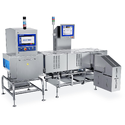 |
Our popular white paper, "How Safe is X-ray Inspection of Food" delivers some astonishing facts about this popular choice for product inspection in food manufacturing.
This paper is essential reading for any food manufacturers with reservations about implementing x-ray inspection into their production, especially those concerned about staff objecting to working with x-rays or consumers switching to competing brands.
The paper addresses some key questions and fears about using x-ray inspection in food manufacturering, including:·
- Why use x-rays to inspect food?
- Do x-rays affect the safety, flavor, texture, or nutritional value of food?
- What is the difference between food inspection and food irradiation?
- What is the difference between x-ray radiation and radioactivity?
- How safe are the x-ray systems used in the food industry?
Download the white paper to learn more!
X-ray Inspection for Food Manufacturers
X-ray inspection technology has become widely used in the food and beverage manufacturing industries around the world over the past few decades. It is used as a means of detecting foreign material contamination, such as metal, glass shards, mineral stone and calcified bone. X-ray systems are also used to perform additional integrity inspections, such as to control portion size or fill levels, check seal integrity and detect packaging defects. Such inspection plays a vital role in maintaining compliance with a range of food safety legislations.







